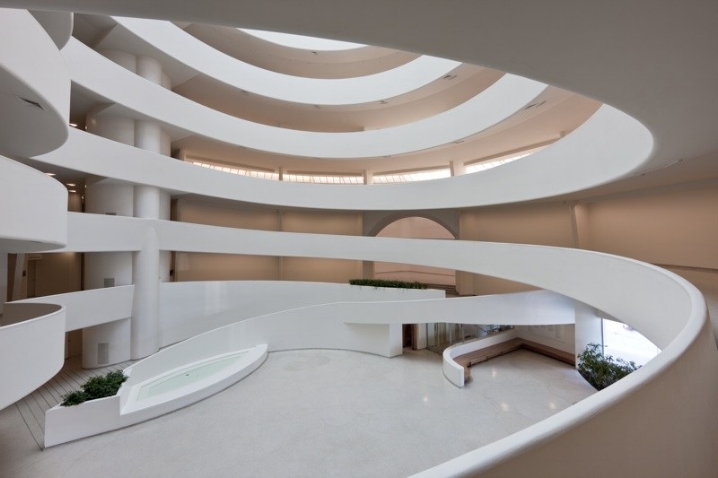Welcome to the second installment of our three-part series exploring the elegance and versatility of terrazzo in some of the world's most iconic architectural projects. We continue with the New York Guggenheim Museum.
In the heart of Manhattan's Upper East Side, the Solomon R. Guggenheim Museum, commonly known as The Guggenheim, stands as a testament to the innovative spirit of 20th-century architecture. Designed by visionary architect Frank Lloyd Wright, the museum's construction journey and its choice of terrazzo flooring symbolize a harmonious fusion of art and architecture. This article delves into the design and construction of the museum, focusing on the significant role of terrazzo flooring in realizing Wright's architectural dream.
The Visionary: Frank Lloyd Wright
The story of the Guggenheim Museum begins in 1943, when Wright was commissioned to design a building that would house and display an extensive collection of modern art. Over more than 15 years, Wright created over 700 sketches and six sets of working plans, each embodying his philosophy of organic architecture. Wright's design was not just a building; it was a "temple of spirit," as envisioned by Hilla von Rebay, the museum's first director.

The Architectural Wonder: Design and Construction
Wright's design was revolutionary, featuring a main gallery with a helical ramp that winds around a light well topped by a skylight. The museum's location on Fifth Avenue, overlooking Central Park, was chosen for its serene setting amidst the city's hustle and bustle. The design and construction faced numerous challenges, including disagreements over basic elements and compliance with building codes. Despite these obstacles, Wright's tenacity and artistic vision prevailed, culminating in a building that, upon its completion in 1959, was celebrated for its innovative and expressive design.
Architecture is our passion, and we find this work so revolutionary, iconic, and representative of terrazzo that we felt compelled to pay it a small tribute. One of our blends is named after this museum. Guggenheim - what a coincidence! - is one of our best sellers.


Why Terrazzo?
Although the first material that comes to mind when thinking of the Guggenheim Museum is concrete, the second most used material within this iconic structure is terrazzo, present on every exhibition floor. Terrazzo is traditional and wonderfully simple.
The origin of terrazzo, as we have mentioned in repeated articles on this blog, dates back to the late 19th century in Italy. There, it was most commonly used in commercial and institutional buildings. Indeed, it was in such a setting that Frank Lloyd Wright decided to use this material in his most iconic and final architectural creation. In a January 1957 letter to George N. Cohen of Euclid Contracting Corporation, Wright described his moment of inspiration:
–When I walked on the floor of the airport in Rome, I said: this is it, the ideal floor for our ramp. It is not overly expensive or they would not have been using it for so many square meters of flooring in an Italian airport. The name of the compound is Terrazzo Acmetyle. I will not accept any substitute that is not familiar with this product–.
Terrazzo was chosen for its durability, ease of maintenance, and aesthetic appeal. Its reflective surface complements Wright's organic architecture, enhancing the fluidity and continuity of the museum. The practicality of terrazzo in a high-traffic public space, along with its subtle yet elegant presence, aligns with the museum's modernist aesthetic. The terrazzo in the Guggenheim's rotunda remains as it was originally installed by contractor V. Foscato Inc. of Long Island City 55 years ago, with little wear from the 1.2 million visitors who walk the museum floors each year. (Parts of the terrazzo in the museum's Thannhauser building have been replaced). The condition of the floors is the result of constant and detailed maintenance: terrazzo requires ongoing repairs and is carefully cleaned and restored using the original Georgia white marble, Portland cement, and additives. This restoration work is carried out with meticulous attention by Larry Godfried, who is a craftsman of his trade, a rare find in the construction industry today. Godfried can often be found working in the museum during our period of change between exhibitions. Its durability is a testament to the meticulous maintenance it receives, preserving its beauty and functionality. Visitors can observe three variations in the color of the terrazzo, each marking a major renovation in the museum's history, providing a visual narrative of its evolution.

The Solomon R. Guggenheim Museum is not just a container for art; it is a work of art in itself. Every element, from the enveloping curves of its exterior to the terrazzo floors, contributes to a cohesive and immersive experience. The terrazzo flooring, in particular, plays a critical role in this architectural symphony, offering a silent but powerful testimony to Wright's genius in integrating form and function. At the Guggenheim, terrazzo is more than a flooring material; it is a canvas that sets the stage for the museum's artistic and architectural dialogues, resonating through time as a symbol of enduring beauty and innovation.

